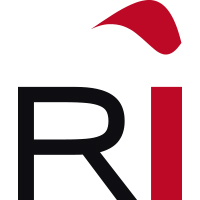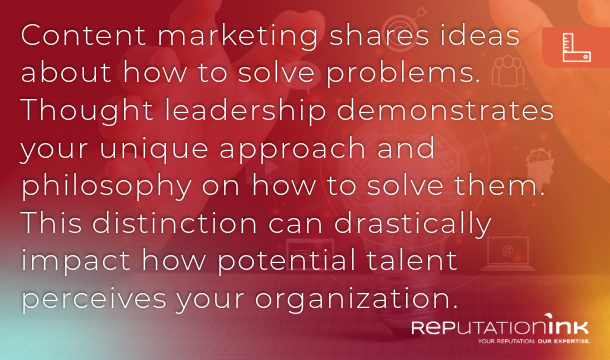The secret ingredient: How thought leadership showcases company culture
Ever ordered your favorite dish at a restaurant, only to find something missing? It looks delicious and has all the same ingredients, but it’s just not the same as when Mom makes it. That love, familiarity and tradition can’t be replicated, no matter how skilled the chef.
The professional world works much the same way. You might land what seems like the perfect job on paper — great salary, impressive title, solid benefits — but without the right company culture, it won’t feel right. Like a home-cooked meal, company culture provides the warmth, connection and sense of belonging that transforms a workplace into somewhere people want to build their careers. It also lets potential employees know whether your company will support their professional growth, welcome forward-thinking ideas, and adapt to the changing technological landscape.
In today’s competitive talent marketplace, culture isn’t just nice to have — it’s critical for attracting and retaining employees. But how do potential employees get a sense of your culture before the interview? One of the most powerful windows into your organization’s values, priorities and personality is through well-executed thought leadership. It doesn’t just showcase your expertise — it reveals the heart and soul of your organization. In a sea of similar job opportunities (all claiming to have “great culture” and “work-life balance”), an authentic display of your company culture through active thought leadership will help exceptional candidates notice you rather than your competitors.
Thought leadership as a cultural mirror
So, what do we mean by “thought leadership” as opposed to “content marketing”? It’s tricky — the terms are often confused.
Content marketing is educational. It’s about creating content regularly to help your prospects do their jobs better. But thought leadership goes a step further. It takes a stand — offers a viewpoint.
Content marketing shares ideas with your audience about how to solve problems. Thought leadership demonstrates your unique approach and philosophy on how to solve them. This distinction can drastically impact how potential talent perceives your organization.
When companies embrace active thought leadership, they communicate these powerful messages about their culture:
- You trust your people’s expertise. When you’re open to team members publishing content under their own names, you demonstrate your confidence in them and their knowledge.
- You value transparency and sharing. Organizations that freely offer insights rather than possessively guarding their “secret sauce” (okay, Gollum, chill — no one’s trying to grab your ring) demonstrate a collaborative mindset.
- You’re committed to growth. Regularly creating thought leadership content shows your company prioritizes staying ahead of industry trends.
Letting younger, more junior people publish shows you’re not hiding your less experienced talent. Don’t restrict thought leadership to just executives or a select few. Go after awards for your relative newcomers or those who don’t typically win. Show that you value diverse perspectives across all levels.
Content marketing shares ideas about how to solve problems. Thought leadership demonstrates your unique approach and philosophy on how to solve them. This distinction can drastically impact how potential talent perceives your organization.
Build a culture that nurtures thought leadership
Creating authentic thought leadership is about more than just asking employees to write blog posts (“yes, we really need 1,500 words”). It requires nurturing a culture where sharing expertise is valued and supported.
Whatever you choose to do, do it consistently. It can’t be haphazard. Creating thought leadership also educates the marketing team and the rest of the company. As they develop the content, the PR and marketing teams gain knowledge to generate stronger material, and it becomes a virtuous cycle.
Here’s how to build a culture that naturally leads to compelling thought leadership:
1. Establish clear guidelines and support
Create frameworks that make participation accessible to everyone. This could include:
- Editorial guidelines that reflect your brand values (so…where do we stand on exclamation points?)
- Regular meetings to brainstorm content ideas (channel your “yes, and”)
- Support systems for those who aren’t super confident in their writing (no shame here!)
Identify the unique perspectives your subject-matter experts (SMEs) have, then collaborate with them to develop distinctive content that showcases their specialized knowledge and reinforces your firm’s authority. At Reputation Ink, we call it knowledge extraction: the art of asking probing questions to uncover your firm’s distinctive stories and expertise.
2. Showcase diverse voices
When you limit thought leadership to senior executives, you miss opportunities to demonstrate the depth of talent throughout your organization.
Restricting thought leadership to senior leaders means not optimizing the talent you have. You have to be able to show clients that you have the expertise to do what they need — at all levels of your organization.
This approach has dual benefits: it demonstrates to potential recruits that all voices are valued and gives talented team members the recognition they deserve.
3. Balance brand consistency with individual expression
Maintaining a consistent brand voice is important, but allowing for personal style to shine through creates more authentic and engaging content.
Let your team members be themselves when they create content. People are tired of the overly controlled message. Younger people want to work at a place that’s doing new, innovative, experimental things. Show your personality.
4. Measure impact and celebrate wins
Track how your thought leadership efforts are performing and recognize those who contribute. This could include:
- Sharing metrics on how articles/posts perform (numbers people love this part)
- Celebrating when content leads to new business opportunities (who doesn’t love a party?)
- Applauding team members whose content performs well (cue the effusive Slack or Teams messages)
Bonus: learning what’s getting the most views and shares on social media helps you develop future content.
5. Remind your employees: It’s good for them, too
Help your team understand the personal benefits of creating thought leadership content. Beyond company visibility, thought leadership offers significant professional advantages for individual contributors.
In many industry awards competitions, people who write articles, give speeches or host webinars have an advantage. These thought leadership activities create a portfolio of expertise that enhances personal brands, opens doors to speaking opportunities, and positions team members as authorities in their field.
When employees see thought leadership as a pathway to their own professional growth and recognition rather than just another company task, they’re more likely to enthusiastically participate and produce authentic, compelling content.
Leveraging thought leadership for recruitment
In today’s competitive hiring market, especially in specialized fields like architecture, engineering and construction (AEC), standing out to potential recruits is crucial.
When firms share thought leadership on social media, especially LinkedIn, potential hires will see that the company values what their employees bring to the table. That’s a place where people will want to work.
Here are specific strategies for using thought leadership to attract talent:
1. Praise your people (Promotion! Success! New haircut! Maybe not that last one)
Use thought leadership to illustrate how your company celebrates and elevates team member achievements. Showcase employees who contribute valuable insights by featuring them prominently in company communications, social media highlights, and marketing materials.
When you amplify those accomplishments across all your channels, it signals to clients and potential recruits that your company recognizes and values expertise at every level. This visible appreciation creates a compelling narrative that says, “Join us, and your contributions will be valued, too.”
2. Highlight team collaboration and innovation
Collaborative thought leadership pieces demonstrate how your teams work together to solve complex problems. This gives candidates insight into your working environment and innovation processes.
Consider creating co-authored content that showcases multiple perspectives from different disciplines within your firm. No one wants to work in a place where everybody’s in their own — corporate speak alert — silos not knowing what the others are doing. Collaborative thought leadership signals to potential hires that yours is a workplace where information flows freely and teams genuinely work together. It appeals to candidates seeking environments where their ideas will be heard and valued, not lost in departmental isolation.
3. Demonstrate industry leadership and vision
The most talented candidates want to work for organizations that are shaping the future of their industry, not just responding to it. By publishing thought leadership that tackles emerging issues like sustainability challenges, technological disruptions, or evolving client expectations, you signal that your company is forward-looking and innovative.
Top talent gravitates toward firms they perceive as industry leaders. When your content consistently addresses what’s next rather than what’s now, you attract professionals who want to be part of building that future.
This approach is particularly effective in recruitment because it creates an aspirational connection. Candidates see your organization not just as a potential employer, but as a vehicle for professional growth and meaningful contribution to the industry’s evolution.
The cost of silence
Some organizations hesitate to invest in thought leadership, citing concerns about time, resources, or the potential of showcasing employees who might get seen — and snatched away by another company. The problem is you’ll be at a significant disadvantage if you stay silent.
You can’t afford NOT to have your name out there. Large professional services firms are gobbling up smaller firms’ work more and more, so you have to promote yourself. If your competitor starts doing thought leadership, you’ll lose out to them. Studies show that there’s a correlation between high-growth firms and investment in thought leadership.
The reality is that in today’s connected world, your employees are already visible on platforms like LinkedIn (did you see Jane’s new profile pic?). Rather than fighting this, smart companies leverage it by supporting their team members in building professional reputations that benefit both the individual and the organization.
The competitive advantage of culture-driven thought leadership
In the battle for talent, particularly the specialized talent in fields like law, architecture, engineering and construction (AEC), companies that effectively communicate their culture through thought leadership gain a significant advantage. When potential employees are sizing up a company, they want to know about the people who are already there. If you don’t showcase your great employees, you won’t get great employees.
By investing in active thought leadership that authentically reflects your company culture, you create a powerful talent attraction strategy that goes beyond salary and benefits. You show potential recruits not just what you do, but how you think, work, and value your people.
The first step? Take an honest look at your current approach. Are you actively showcasing the expertise within your organization? Are you demonstrating your company’s values through the content you share? If not, there’s no better time to start than now.










